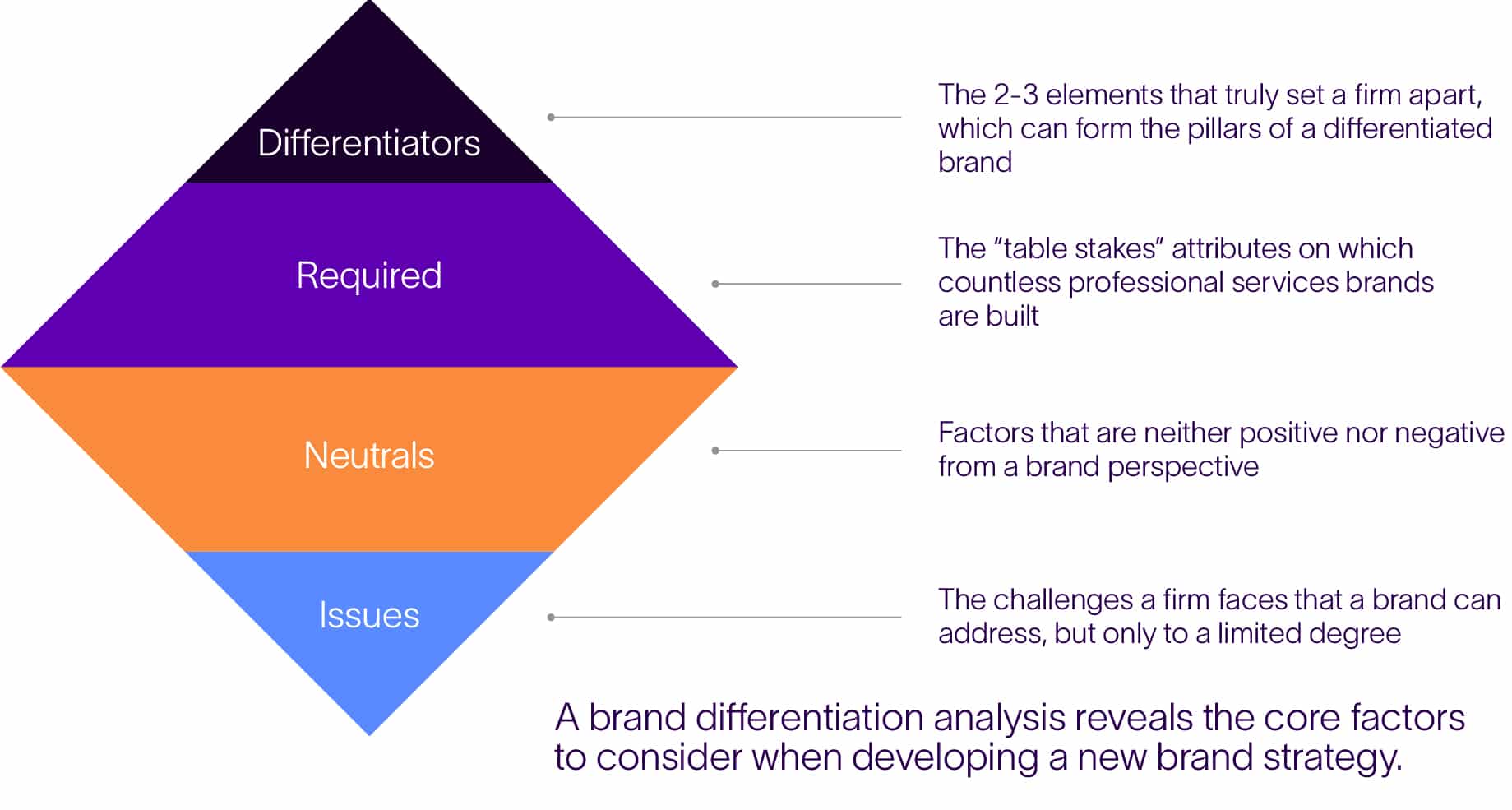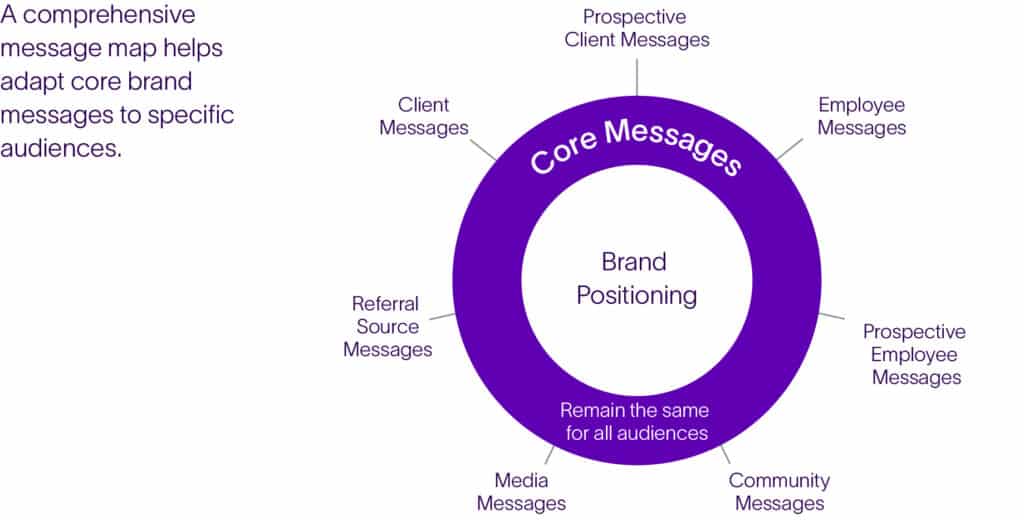Subscribe to Our Newsletter
For those in search of the right relationship, messages from professional services firms can take on a familiar ring. “We are committed to meeting client needs.” “We have deep industry expertise.” “We have a culture of transparency and trust.” These statements may be true—in fact, it’s quite important that they are. But while they succeed at making a firm sound capable and reputable, they do not empower it to stand out in the competitive professional services arena.
The Critical Need to Differentiate in Professional Services
For decades, professional services firms went to market with undifferentiated messages without necessarily suffering any adverse effects. The need to make a uniquely compelling connection with clients or talent was simply less critical. A strong economy and record corporate profits ensured there were plenty of audit, legal and consulting engagements to go around.
Then the financial crisis of 2008—followed by weak corporate profits, widespread bankruptcies and belt-tightening in every industry sector—transformed the professional services landscape. Customers started asking accounting, law and consulting firms to cut their fees or participate in RFP battles to retain previously-stable relationships. Compounding the challenge was an erosion of trust due to well-publicized fraud in the financial industry; negative headlines inevitably casting a dim light on all professional services firms having anything to do with wealth and investment management.
As a result, “Me-too” brands are no longer effective at attracting and engaging customers in professional services. Corporate CEOs, CFOs and others are looking for reasons to believe in their partners—and this is where a strong, differentiated brand comes into play.
Brand, uniquely, can both set a professional services firm apart from competitors while developing the connections and goodwill that lead to customer loyalty and employee retention. In what has become a far less stable environment, it can build a firm’s strength.
The Prevalence of “Table Stakes” Branding
Not that long ago, our branding firm was retained by a leading accounting, tax and strategic advisory firm to develop a new brand strategy. The firm had doubled in size following a merger. Leadership needed to identify the core attributes shared by the legacy firms, which could be used to build a sustainable brand that would drive enduring value creation.
We began by taking a fresh look at branding across the professional services space. And in doing so, we were struck by what we refer to as “the sea of sameness.” At a time when the need to differentiate is more critical than ever, professional services by and large continue to communicate the same anodyne messages and claim the same relatively interchangeable attributes.
An analysis of the top ten accounting firms, for example, revealed that six firms built their brands around the principle of “client-centricity.” Key messages centered on the “client experience,” “strong relationships” and “attentive service.” Runner-up attributes—”value,” “quality” and “integrity”— also failed to differentiate any firm meaningfully.
We observe the same trend in the consulting segment, where firms build their brands around common themes like “premium client service,” “customized solutions” and “global reach.” The largest law firms emphasize the global nature of their offering as well. These businesses also highlight their pro bono work—but more as an adjunct to what they do rather than an integral part of who they are.
This collection of the most common brand attributes in professional services tells the tale.

To be clear: there is certainly nothing wrong with being focused on the client. But all of these attributes are merely “table stakes.” They’re must-haves (or “jacks for openers,” to extend the poker metaphor), but they also represent baseline expectations—not competitive game-changers. After all, if a CEO or CFO believed that a firm wouldn’t be focused on their needs, or would not pride itself on the quality and integrity of its work, would they even consider engaging them in the first place?
Yes, quality and integrity matter. Table stakes messages deserve some place in the brand platform. But they do little to set a firm apart when they appear in top-line messaging or as lead promises. They do not represent what today’s talent or customers are looking for: a partner who brings something to the relationship that no other firm does, a business that understands their needs more deeply and partners more meaningfully to meet them.
Breaking Through the Clutter with Content
Many large segments of professional services attempt to overcome their growth challenges by focusing efforts on content marketing rather than traditional communications channels like advertising. Law firms, consultants and accountants are turning to white papers, videos, webinars, surveys and newsletters as increasingly important components of their communications platforms.
They do this for good reason. As detailed in our Insights post B2B Marketing: Why Content is the New Creative, content has become the lifeline that B2B marketers need to break through the clutter and make meaningful connections in their complex environments.
Buyers of professional services are increasingly skeptical of traditional marketing but open to other means of learning about a firm, its services, the relationships it forms and the benefits of long-term partnership. While a catchy slogan or ad is no longer enough to move them, enlightening thought leadership can be. Even notoriously hard-to-read decision makers in the C-suite will find time for high-value content (as we cover in Unlocking the C-Suite: Why Content Is Key). The reason is simple. Today’s purchasers and decision makers want to be informed, educated, enlightened—not sold to.
Of course, creating, managing and distributing content is its own complex process. Quality content takes time to develop, and you can’t just publish an article and expect prospects to find it. Waves of effective, sharply relevant digital marketing tactics are required to get carefully-crafted content in front of the right people. During the research phase of a recent branding initiative for a leading law firm, we found very few clients were even aware that they were receiving white papers from the firm.
Unfortunately, the growing popularity of content as a marketing tool has led to a new challenge. Everyone is publishing and distributing content, including the biggest firms, who have entire departments devoted to generating white papers and other literature. Again: meeting core expectations is not enough. It’s vital to stand apart as providing something truly unique.
Engaging, Informing and Empowering Employees
Many professional services firms face another common challenge: their clients aren’t aware of the firm’s full breadth of offerings, even though they may be in direct contact with its employees on a frequent basis. At all levels, from staff through partner, everyone at a firm should be knowledgeable about the complete solutions set. Surprisingly often, they are not. There is an “awareness gap.”
Employee awareness gaps can be particularly wide within firms that have expanded and diversified through acquisitions or even organic growth. Professional services firms can offer a highly diverse array of offerings. But no matter the reason behind an employee awareness gap, the path to bridging it is clear: leverage brand to engage, inform and empower employees with both deeper understanding and a sense of unified purpose.
Precisely because these organizations and their services can be so expansive, we believe employee engagement is a critical component of a successful branding initiative for any professional services firm, and that the strongest brands are built from the inside out. Meaningful employee engagement drives value creation, empowering and inspiring teams to tell the firm’s greater value story and promote its complete offering to clients and prospects. Employees become advocates and even champions for the firm. Every employee sells.
Building a Differentiated Brand: Where to Start
So, how can a professional services firm stand out? Is it possible to create a brand that will establish a distinctive and compelling position, one that connects people to the business and thereby drives value creation?
It is. And it starts with information, which is as important to branding as it is to preparing an audit or legal brief.
External interviews can uncover how the firm is perceived today—essentially, your current brand, which is the sum total of what your most important audiences think, feel and believe about you. To be truly effective, however, research should also include internal audiences: your staff and most valuable clients. These internal interviews (individual or group) should focus on how these all-important groups perceive the firm today and how they would like it to evolve in the future.
Between the firm’s position today and audiences’ aspirations for its future is your “brand gap.” Provided it is built and deployed effectively, your new brand can help you bridge that gap—attracting and engaging the people you need today with a compelling, shared vision for the future.
Research will also help identify the attributes or pillars on which to build the brand that can not only bridge your brand gap but differentiate your firm. At this phase, the challenge will be to distinguish between required attributes—the ones that all players must have—and the truly unique attributes that only your firm can credibly claim.
Consider this Brand Differentiation Analysis exhibit, which includes all the elements and attributes that a professional services firm needs to consider when building a differentiating brand. There’s a good reason it is diamond-shaped: most firms have many more Neutral and Required factors than Issues and Differentiators.

Starting at the bottom, a firm will inevitably have a few Issues (aka challenges) to address. Maybe your firm has had a lot of turnover recently. Or maybe there’s only a perception that employees are exiting (from a brand perspective, there isn’t much difference, unfortunately). Brand can’t eliminate turnover; it’s a challenge to address on many fronts. But new messaging can project an image of greater stability that may reassure clients and attract talent with a deeper intention to stay with the firm.
Next, firms must pinpoint their Neutrals: factors that are neither positive nor negative from a brand perspective. Many professional services firms tout their longevity—having been in business for 25 years, for example. That’s quite an achievement, but longevity may not be compelling to a prospective client who needs what they perceive as modern, sophisticated services. Neutrals aren’t bad, and they often find their way into supporting messages. But they are not the pillars of a differentiated brand.
Next, firms must identify their Required factors. As noted above, these “table stakes” are precisely the attributes that most professional services brands are built on. But competitors will claim them as well, meaning they won’t be differentiating. Remember: they cannot be brand pillars, they are essentials.
Finally, firms must unearth their Differentiators: the attributes that can make a brand truly stand apart. Finding the two to three factors that can support a brand isn’t easy. It requires digging deep through research, as well as analyzing the competition and their brands. But every firm has them.
Consider this DeSantis Breindel case study:
During a branding engagement for a large law firm, our interviews with clients revealed that while they greatly appreciated the expert legal advice they received from the firm, what they truly valued was how the firm’s attorneys looked beyond strictly legal issues to understand their industry, their competitive landscape and their long-term goals and personal aspirations. The attorneys were seen as unafraid to “roll up their sleeves” to discover what makes their clients tick, then explore how the law could be a catalyst for their growth rather than a barrier to their progress.
This finding led to the development of a differentiating law firm brand based on the concept of “See Beyond.” For clients, this firm sees beyond narrowly defined legal issues, beyond conventional wisdom, beyond the expected—and that is their greatest point of value.
A new visual identity supported and activated this brand strategy, setting the firm clearly apart from its competitive set from the first website visit.
Developing a Positioning and Messaging Platform
The differentiated attributes that firms discover need to be woven together into a cohesive brand strategy, codified in a positioning statement. Positioning defines what is unique about the firm and what singular value it delivers to its clients. The statement should be true and defensible but also aspirational, reflecting not only where the firm is today but where it plans to go.
Positioning is then expressed through a new brand voice. How should your firm “sound” in its communications: authoritative or collaborative? Visionary or practical? Your positioning and messages will be most credible when they speak to your audiences in what sounds like their own language. The strongest professional services brands meet people where they are, offering them the relationship they need to face the road ahead with confidence.
We always extend our brand strategies to that critically important communications tool, the message map. This tool includes “core messages” that the brand must communicate across touchpoints and interactions. Think of these as the messages you might find on a firm’s homepage. They occupy prime brand real estate, and they must be compelling and relevant to connect with all the firm’s audiences.
The message map expands to include individual messages to specific audiences, including clients, prospects, referral sources, employees and recruits. With such a map, firms can easily develop communications tailored to each audience whenever they need, removing all guesswork. It also provides them with the guidance they need to ensure invaluable B2B messaging consistency, the firm’s brand strengthened with each new message it shares.

Creating a New Visual Identity
With its brand strategy in place, the professional services firm is ready to create a visual identity, or what we call its “design language.” Differentiating, compelling and memorable, it’s designed to leave audiences with a lasting impression of the firm.
A firm’s design language provokes intellectual and emotional responses among key constituents, both internal and external, by harnessing design’s power to signal important attributes, promises or experiences. It includes different forms and shapes, uses of color and graphic styles, along with strategies for typography, photography and illustration. It creates connections with people by signaling that the firm understands their needs and comes with the perspective they seek on their challenges. Audiences may not be able to articulate why, but whenever they encounter the firm’s visuals, they instinctively feel they are in the right place.
Once all the key components of a firm’s visual identity are set, guidelines can again ensure consistency against all communications and touchpoints—the firm’s differentiated brand becoming instantly recognizable.
Launching Your Differentiated Professional Services Brand
Once a new professional services brand is fully built, the firm’s new positioning, messaging and design language form the basis for all of its communications. From its web presence advertising to employee engagement programs, the brand is cohesive and motivating, building value-driving connections.
To ensure maximum effectiveness, brand implementation should be synchronized at all internal and external touchpoints. This requires significant planning and often demands cooperation among many departments: marketing, human resources, operations and senior management. But the investment in up-front planning is more than worth it. When properly synchronized, the brand will drive value creation each time it touches an internal or external audience.
Finding a unique brand position in a field as crowded and competitive as professional services is challenging. It will remain tempting to fall back on familiar, formerly tried-and-true claims and ideas. But in today’s fee-sensitive climate, there’s nothing safe about an undifferentiated professional services brand.
Me-too branding may secure a seat at the professional services table. But only a truly unique brand will ensure a winning hand—and create value for the firm.
To discuss partnering to create a differentiated professional services brand, contact us.
Originally published July 17, 2022.



